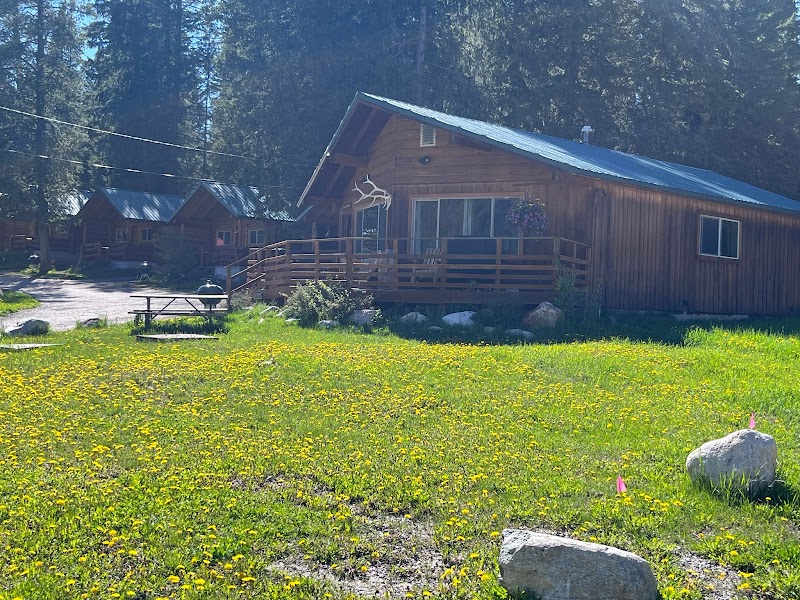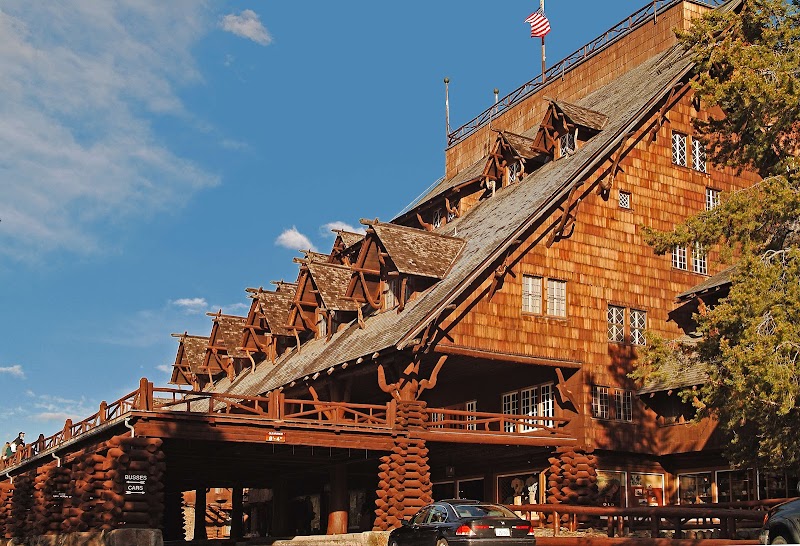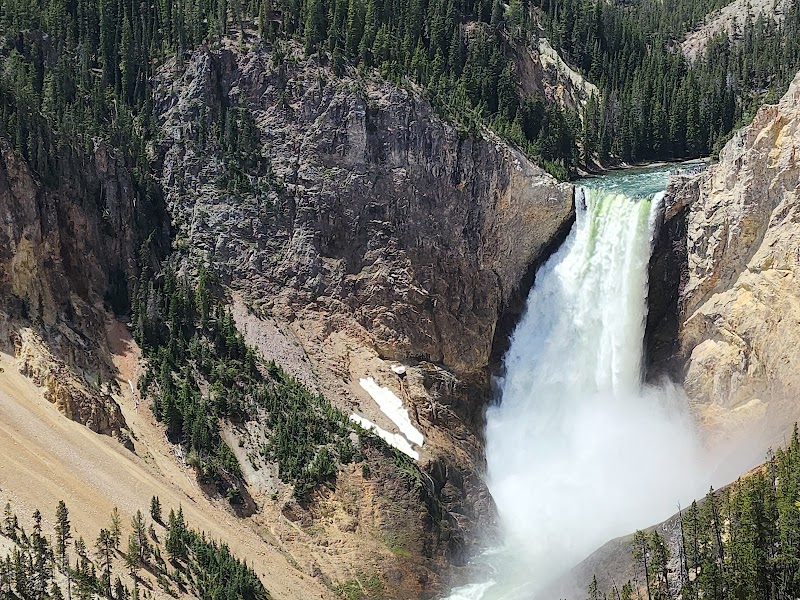Welcome to Yellowstone National Park
If you are looking for a place of wonder, where the magnificence of nature unfolds itself in the most unique ways, look no more. Welcome to Yellowstone National Park, a sprawling expanse of 2.2 million acres, home to geysers, hot springs, and the largest concentration of mammals in the lower 48 states. Marvel at the Old Faithful, the Grand Prismatic Spring's riot of colors, and the dramatic landscape of the Grand Canyon of the Yellowstone, each testament to the raw majesty of nature.
To navigate this vast wilderness and discover its many surprises, you need more than just courage; you need a guide. This tourist map of the United States’ Yellowstone National Park becomes your essential companion in planning a journey you won't forget.
" Booking.comExploring Yellowstone National Park: An Encounter with Wilderness
As you chart your course through Yellowstone National Park, you'll see a world where wilderness reigns supreme and Mother Nature's grandeur echoes at every turn.
Top Attractions and Experiences in Yellowstone National Park
Embarking on a journey through Yellowstone National Park, there are myriad attractions and experiences to captivate your senses and ignite your spirit of adventure. Let's delve into the must-visit spots:
- The Hayden Valley
- The Norris Geyser Basin
- Mammoth Hot Springs
- Lamar Valley
- Mount Washburn
The Hayden Valley: A Wildlife Enthusiast's Paradise
Roaming through the Hayden Valley is akin to being in a live wildlife documentary. This lush valley is a haven for bison, elk, and grizzly bears. The meandering Yellowstone River adds to the picturesque view. On a tourist map of the Rocky Mountain National Park, you'll see it's a key attraction not to be missed.
Norris Geyser Basin: The Hottest Spot in the Park
There's no place in Yellowstone National Park that lets you feel the earth's pulsating heartbeat as vividly as the Norris Geyser Basin. This is the park's oldest and hottest thermal area, offering a unique insight into the park’s volcanic origins. The Echinus Geyser, the largest acidic geyser in the world, puts on a mesmerizing show of nature’s power.
Mammoth Hot Springs: A Geological Wonder
Mammoth Hot Springs is a showcase of nature's architectural spectacle, with terraced formations created by the deposit of minerals from the hot springs. The area's vibrant colors, a result of different bacterial colonies thriving in the varying temperatures, create a stunning vista that is a photographer's delight.
Lamar Valley: The Serengeti of America
Often referred to as the 'Serengeti of America', the Lamar Valley is one of the top spots in the park for wildlife viewing. As dawn breaks, you may witness the surreal sight of wolves on the hunt, a testament to the park's thriving ecosystem. For bird watchers, the sight of golden eagles, ospreys, and peregrine falcons soaring across the sky is a delight.
Mount Washburn: An Unforgettable Hike
For the adventurous at heart, a hike up Mount Washburn is a must. The trail rewards with panoramic views of much of the park, including the Grand Canyon of Yellowstone and the Teton Range. You may spot bighorn sheep or a grizzly bear in the distance, making the trek a thrilling blend of physical challenge and wildlife spotting.
In every corner of Yellowstone National Park, you'll experience nature's majesty, from its abundant wildlife to its awe-inspiring geothermal features and stunning landscapes. Your journey through this remarkable land will leave you with a deep appreciation for the power and beauty of the natural world.

Practical Information for Yellowstone National Park
Transportation and Mobility
The park is served by five entrances, each leading to different regions with unique experiences. It's essential to plan your route in advance, taking into account where you'll be staying and the attractions you want to visit. The road system in Yellowstone is mainly two-lane roads, so anticipate slower travel times, especially during peak season when traffic is heavier. Free parking is available at all major sites, but it can fill up quickly during peak season.
While Yellowstone National Park does not provide public transportation, several private companies offer guided tours. These can be a great way to explore without the hassle of driving, especially during busy times.
Schedules and Prices
Yellowstone National Park is open 24 hours a day, year-round, but some areas are inaccessible by car in the winter due to snow. The park's visitor centers, historic sites, and shops have varying operating hours, so it's best to check the official website before your trip.
The entrance fee for a private, non-commercial vehicle is $35, valid for seven days at both Yellowstone and Grand Teton National Parks. Annual passes for Yellowstone alone are available for $70, while a $80 America the Beautiful Pass grants unlimited access to all federal lands for a year.
Safety Tips
Staying safe in Yellowstone National Park involves respecting wildlife and understanding the dangers of geothermal areas. Maintain a distance of at least 100 yards from bears and wolves, and 25 yards from all other animals. Never approach or feed wildlife. When exploring geothermal areas, stay on boardwalks and trails, and keep children close.
Forest fires can occur in Yellowstone, especially during dry summer months. Stay informed about current fire conditions and restrictions, and always completely extinguish campfires.
Practical Recommendations
For the best experience, consider visiting Yellowstone during the shoulder seasons (April to May and September to October), when the park is less crowded and wildlife viewing is excellent. The weather during these times can be unpredictable, so pack layers and be prepared for changing conditions.
Plan your meals in advance as dining options within the park are limited and can be busy during peak times. Bringing a cooler with snacks and meals is a great way to ensure you have plenty of food and can eat whenever and wherever you like.
Cell service in Yellowstone is limited and Wi-Fi is only available at select locations. Consider downloading maps and other information you may need ahead of time. Remember that the focus here is on disconnecting and immersing yourself in nature.

Frequently Asked Questions about Yellowstone National Park
1. What are the best times of the day for wildlife spotting in Yellowstone?
Wildlife in Yellowstone National Park is most active during the early morning and late evening hours. It's especially productive to set out just after dawn or before dusk for the greatest chance of viewing creatures like bears, wolves, and elk. However, always ensure you maintain a safe distance from wildlife and never approach or feed animals.
2. Can I fly a drone in Yellowstone National Park?
Operating drones within the boundaries of Yellowstone National Park is strictly prohibited. This rule is in place to protect wildlife from disturbance and maintain the natural soundscape of the park. Violations can result in hefty fines and potential confiscation of the drone.
3. Are there any specific hiking rules in Yellowstone?
Yes, there are. Hikers are required to stay on designated trails, and off-trail hiking is prohibited in certain areas to protect delicate vegetation and geological features. Always remember to carry bear spray, hike in groups, and make noise while hiking to alert wildlife of your presence.
4. Can I go fishing in Yellowstone National Park?
Yes, you can. Yellowstone National Park offers some of the world's best trout fishing. However, a fishing permit is required, and there are specific regulations regarding seasons, catch limits, and tackle restrictions that you should familiarize yourself with before casting your line.
5. Are there guided tours available in Yellowstone National Park?
Yes, guided tours are available and can provide a deeper understanding of the park's geology, history, and wildlife. Options include bus tours, horseback rides, boat trips, and even llama packing adventures. Be sure to book in advance as these tours are popular and can fill up quickly.
6. What should I do in case of a geothermal feature emergency?
If you witness someone falling into a geothermal feature, do not attempt a rescue yourself as the water can be boiling hot. Immediately notify a park ranger and provide as much information as possible about the location and nature of the incident. Remember, safety is paramount in Yellowstone and it's crucial to stay on boardwalks and trails in thermal areas.

